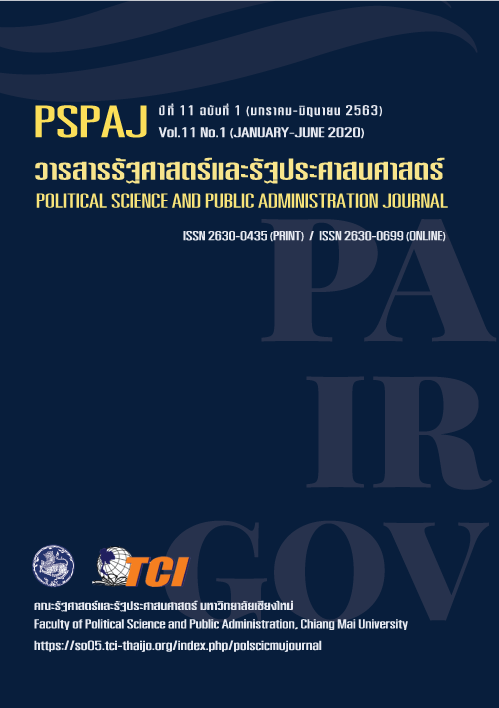International Tourists’ Self - Protection from Becoming Victims of Crime at Khao San Road, Bangkok
Main Article Content
Abstract
The purposes of this are three points: (1) to examine the extent to which international tourists visiting Khao San Road, Bangkok have protected themselves from becoming victims of crime, (2) to compare the level of self-protection among international tourists with different genders, age groups, nationalities, number of travels, number of people travelling with, the consumption of news reports on crime and personal experiences of falling victim to crime, and (3) to provide information to those involved in determining guidelines or finding ways to reduce crime in the area of Khao San Road. Data in this research was collected from 100 international tourists visiting Khao San Road. When it comes to data analysis, descriptive statistics such as percentage, arithmetic mean, standard deviation were used to present the collected data while inferential statistics such as T-Test and ANOVA were adopted for the comparison of the level of self-protection among international tourists. The finding indicate an average level of self-protection against becoming victims of crime among international tourists at Khao San Road. The finding also show that the level of self-protection of international tourists with different genders and personal experiences of falling victim to crime are statistically different at 0.05.
Article Details
- เนื้อหาและข้อมูลที่ลงตีพิมพ์ในวารสารรัฐศาสตร์และรัฐประศาสนศาสตร์ถือเป็นข้อคิดเห็นและความรับผิดชอบของผู้เขียนบทความโดยตรง ซึ่งกองบรรณาธิการวารสารรัฐศาสตร์และรัฐประศาสนศาสตร์ ไม่จำเป็นต้องเห็นด้วย หรือร่วมรับผิดชอบใดๆ
- บทความและข้อมูล ที่ได้รับการตีพิมพ์ในวารสารรัฐศาสตร์และรัฐประศาสนศาสตร์ ถือเป็นลิขสิทธิ์ของวารสาร หากบุคคลหรือหน่วยงานใดต้องการนำข้อมูลไปใช้ประโยชน์ในทางวิชาการ ขอให้อ้างอิงแหล่งที่มาด้วย
References
กรมการท่องเที่ยว. (2561). ข้อมูลสถิตินักท่องเที่ยว. สืบค้นเมื่อ 23 มกราคม 2561, จาก https://www.mots.go.th/main.php?filename=index
ไชยวัฒน์ อัศว์ไชยตระกูล. (2556). การรับรู้เกี่ยวกับอาชญากรรมและความปลอดภัยของนักท่องเที่ยวชาวต่างชาติที่มีอิทธิพลต่อการกลับมาท่องเที่ยวซ้ำและแนะนำแหล่งท่องเที่ยว กรณีศึกษาถนนข้าวสาร กรุงเทพมหานคร. (ศิลปศาสตรมหาบัณฑิต), บัณฑิตวิทยาลัย, มหาวิทยาลัยมหิดล.
ธิดามาศ โพธิดารา. (2552). แนวทางการป้องกันตนเองไม่ให้ตกเป็นเหยื่ออาชญากรรม กรณีศึกษานักเรียน นักศึกษาที่อาศัยอยู่หอพักเอกชนในจังหวัดนครปฐม. (สังคมสงเคราะห์ศาสตรบัณฑิต), การบริหารและนโยบายสวัสดิการสังคม มหาวิทยาลัยธรรมศาสตร์.
วารานัย ยุวเตมีย์. (2559). การรับรู้ความเสี่ยงของนักท่องเที่ยวต่างชาติที่เดินทางมาท่องเที่ยวใน ประเทศไทย. (ศิลปศาสตรมหาบัณฑิต), สาขาวิชาการจัดการท่องเที่ยว คณะการท่องเที่ยวและการโรงแรม มหาลัยธุรกิจบัณฑิตย์.
สิริรัตน์ บำรุงกรณ์. (2552). อาชญาวิทยา ทัณฑวิทยาและเหยื่อวิทยา. ปัตตานี: คณะมนุษยศาสตร์และสังคมศาสตร์ มหาวิทยาลัยสงขลานครินทร์.
สุดสงวน สุธีสร. (2547). อาชญาวิทยา. กรุงเทพฯ: สำนักพิมพ์มหาวิทยาลัยธรรมศาสตร์.
สุนิสา อินอุทัย. (2557). การป้องกันตนเองไม่ให้ตกเป็นเหยื่ออาชญากรรมของประชาชนในเขตพื้นที่ตำบล แสนสุข อำเภอเมืองชลบุรี. (รัฐประศาสนศาสตรมหาบัณฑิต), วิทยาลัยการบริหารรัฐกิจ มหาวิทยาลัยบูรพา.
ไทยรัฐออนไลน์. (2561). บุกรวบกะเทย ลวงฉกทรัพย์ นายแบบโสม. สืบค้นเมื่อ 17 กุมภาพันธ์ 2561, จาก https://www.thairath.co.th/content/1204762
อัจฉรียา ชูตินันท์. (2557). อาชญาวิทยาและทัณฑวิทยา. กรุงเทพฯ: วิญญชน.
อัณณพ ชูบำรุง, และอุนิษา เลิศโตมรสกุล. (2555). อาชญากรรมและอาชญาวิทยา. กรุงเทพฯ: สำนักพิมพ์แห่งจุฬาลงกรณ์มหาวิทยาลัย.
Boakye, K. A. (2010). Studying Tourists: Suitability as Crime Targets. Annals of Tourism Research, 37(3), 727-743.
George, R. (2010). Visitor Perceptions of Crime-safety and Attitudes Toward Risk: The Case of Table Mountain National Park, Cape Town. Tourism Management, 31, 806-815.
Hentig. (1979). The Criminal and His Victim. Schocken Books: New York.
Mathieson A., and Wall G. (1982). Tourism: Economic. Physical and Social Impacts. London: Longman.
Prideaux, B. (1996). The Tourism Crime Cycle: A Beach Destination Case Study. In a Pizam, A., & Mansfeld (Eds.). Tourism, Crime and International Security Issues. (pp. 59-77). Chichester: John Wiley & Sons.
Reisinger, Y., & Mavondo, F. (2006). Cultural Differences in Travel Risk Perception. Journal of Travel & Tourism Marketing, 20(1), 13-31.
Richardson, S., & Crompton, J. (1988). Vacation Patterns of French and English Canadians. Annals of Travel Research, 15(3), 430-545.
Schafer, S. (1968). The Victim and His Criminal. Random House: New York.
Walker, L., & Page, S. J. (2007). The Visitor Experience of Crime: The Case of Central Scotland. Current Issues in Tourism, 10(6), 505-542.
Wolfgang, M. (1958). Patterns in Criminal Homicide. John Wiley: New York.
World Tourism Organization. (2016). World Tourism Organization. Retrieved January 23, 2017, from http://www2.unwto.org/en


